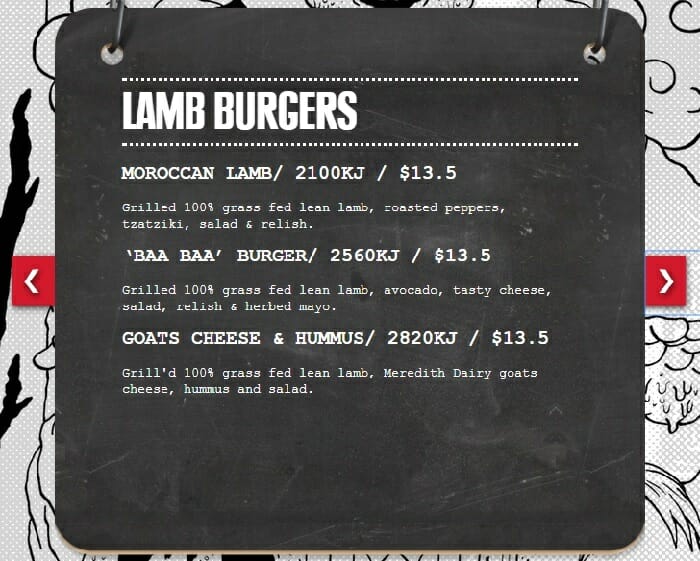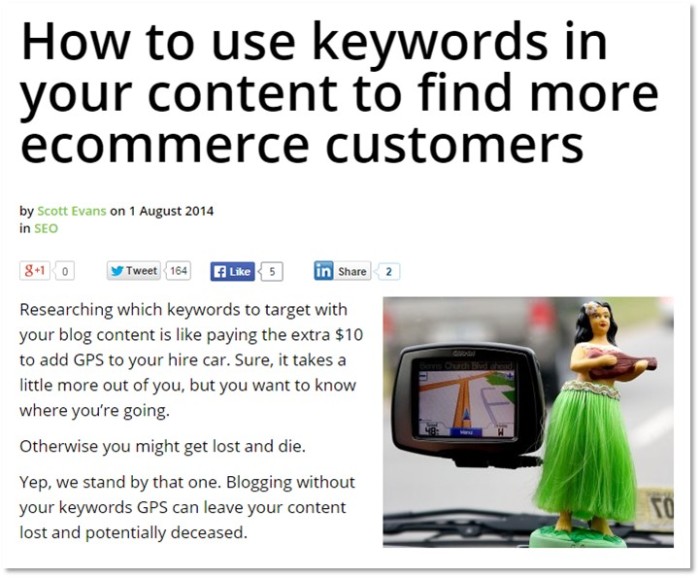Optimising your on page content is really simple. It’s also the easiest way to improve your SEO.
Weekly, if not daily, ecommerce marketing requires fresh, original content. If you’re uploading or scheduling this content, you can make sure it’s in tip top SEO shape. You just need a little help in the right direction.
In this post, we explain how you can use 5 key areas of your content to bring yourself more potential customers from search engine results. These guidelines are taken from our 70 page DIY Ecommerce SEO Guide.
If you want a detailed guidebook to help you and your team improve your existing content, grab your copy now.
The guidelines are super simple. If your uploading new content, it will take you less than 15 minutes to make sure your content is optimised for search engine dominance.
Why SEO is like Cryptic Crosswords
You read it right, SEO is like the internet’s version of a cryptic crossword. Stick with me…
If you’re selling online, search engine rankings matter.
I don’t have to tell you why. I’m sure your boss already does.
Just in case you need remind yourself, the proof that ecommerce needs SEO is here.
But knowing you need to improve your rankings and actually making it happen are two different things.
Just like cryptic crosswords.

Only a small fraction of nerdy people seem to know how to do it. You want to get involved and learn, but every time you venture into the depths of murky confusion you can’t even work out where to start. You might get one or two things right, but you can’t tell if it’s a fluke or you’re finally on to something.
Well, like the cryptic crossworders of the world, SEO’s aren’t really that magical. There’s a pretty set formula and some easy-to-follow rules. They understand the benefits of eCommerce SEO and the steps needed on the way.
The people in the know aren’t any smarter than you, they just learned the secrets. Once you’re in on these ‘secrets’, you start getting the hang of it. Next thing you know – you’re part of that mystical group of society that have mastered one of the least cool skills you could think of (sorry fellow SEO pro’s, but everyone really does think we’re as lame as crossword enthusiasts…)

Strange analogy aside, ecommerce SEO is a whole lot easier with a little expert direction. Any ecommerce pro can master the majority of techniques that you need to make sure your content is search engine friendly.
Here’s the 8 ways you can improve your ecommerce content’s rankings. You’ll learn how to dominate them.
You’ll also learn how to find, check, fix and prevent errors in each of these 8 areas.
#1. Optimising your site URLs/Permalinks
Google prefers ‘clean permalinks’ or descriptive URLs to easily identify the content or theme of a page for users. The nerdy and somewhat unnecessary SEO term for these is SEF URLs (Search Engine Friendly).
Yeah, we know, SEF sounds so much more technical. Evidently we like people to think we’re a whole bunch smarter than we are.
It’s best to start your ecommerce site with keyword rich, descriptive URLs.
Sadly, if you have an established store with thousands of products, it can be exceedingly complex and time consuming to update your URLs for SEO friendliness.
Google advises that it may be worth putting your time into other improvements rather than changing the permalink structure of your website. If you have a well established site, there’s also a risk that changing your URLs to something more SEO friendly won’t give you much benefit at all.
How to find out if you can improve your URLs:
Take a virtual joyride through your store’s URLs (alas, that makes it sound a little more exciting than it really is) and decide whether the text is descriptive. Here’s an example of the kind of URL work that Google’s robots love:
- Yoursite.com.au/category/sub-category/product
Can you decipher what your pages might be about without even looking at the content? If you can, congrats – you have clean permalinks, or as us search nerds would say: SEF URLs.
If your URLs look more like an ASIO secret codename than a webpage headline, search engines are going to have a hard time working out the cut of your jib.
Permalinks with numbers, special characters or shorthand words give Google little or no indication of your content. Keep the Batman symbols and internal acronyms out.
Permalinks like this are non SEF URLs:
- Yoursite.com.au/*p3/product23?.html
How to make your URLs Search Engine Friendly:
If your URLs are to Google what Morse code is to a five year old, you have a little bit of work to do. Most content management systems allow you to make changes.
Search for the ‘URL settings’ options or within your configuration menus.
Change your URL to include your page’s target keywords, like we have here with the phrase “ecommerce-better-than-ppc”.

You probably want to keep the rankings juice from your page’s previous performance. To make sure of this, you need to make sure that your previous non SEF URLs have automatic ‘301 redirects’ setup to the new SEF URLs.
If you don’t have automatic redirects set up, map out your old URLs and match them with manual redirects to the new versions.
If you can’t find an easy option within the CMS to make these changes, this could be the time to call in the experts. We don’t want you accidentally redirecting your homepage to a 4 year old blog post on the reasons why pastel prints will be the new black for summer 2011.
#2 Optimising title tags and meta descriptions
Title tags are one of the most influential on page elements for your search engine rankings performance. Search engines use these tags as an important indication of the nature of your content. They also stare your potential customers right in the face on Google results pages as you can see right here:

To optimise your title tags, use your primary keywords at the start. Of course, make sure your title intrigues and informs your customers as a first priority. Slip in your keywords wherever they make sense.
Google also advises us SEO pro’s that using your brand name in title tags across the site is a good idea. This is another way to thread a link through all of your different pieces of content back to a common denominator, helping you squeeze your rankings juice around your site.
Here’s a simple example of a title tag that would bring a smile to a Google bot’s face:
- Burtons Snowboards Online | Your Site Name
It’s easy to sort out your title tags for SEO:
Review the pages on your site and make sure your title tag and meta description are bang on. If you think you can improve your SEO or your customer readability, 95% of the time you can edit these easily through your content management system.
Out of all the onsite changes you can make, prioritise title tags. These bad boys give you the most bang for you buck.
They are easy to change and they mean a big deal to Google.
If you can fit some keywords you want to rank for into your title tags, you’ll probably find yourself some new potential customers from your old pal Google. Meta descriptions can also be low effort – high reward. If you can make things more enticing, you can influence your click through rates instantly, leading to swift increases in traffic.
Optimising Your Meta Descriptions
Meta Descriptions are the miniature content summaries that you can see below the Title tags in search results;

Search engines don’t take this information into account to determine your ranking.
But, you need to remember – Customer first, Google second.
Your meta descriptions are like the blurb of a bestseller. You have a great chance to convince a potential customer to visit your web store, so you’d better make sure you’re little meta teaser is as descriptive and enticing as possible.
The best practice for meta descriptions is to write unique, compelling snippets of text which entice users to click on your website.
In the image above you can see how we’ve included our keywords in the meta description. If the customer searches for “using images in content marketing”, any of these keywords will be shown in bold in your meta description. even though Google doesn’t take this into account, your potential customer does.
Seeing those bold keywords appear is like a magnet to their scanning eye. It could be the difference between a click (and a possible sale) or a miss.
Using our snowboards example, here’s a meta description that uses a collection of potential keywords and search terms. It also uses some persuasive, helpful and informative copy to urge searchers to click through to the content.
- We have the largest range of Burton Snowboards for FREE Australia wide delivery. Now 20% off storewide. See our website for details!
#3. Optimising your subheadings
Headings are super important for search engines rankings and for your customers. Using keywords intelligently in your subheadings is one of the quickest ways to improve both. In fact, we wrote a whole post about it.
We called it 1 simple on page optimisation hack that will bring you more customers.
Good heading right?
We gorillas try to practice what we preach.
You know by now that the on page optimisation hack we’re talking about is about headings. Specifically, about optimising your subheadings for longer tail keywords. No clickbait headlines here – just helpful spoilers!
Use your primary keywords in your title or “H1” heading, like you would your title tag.
The trick to improving your ecommerce SEO is in your subheadings
Break up your content into sections, particularly if you’re righting longer form content. This helps readers to skim your content and understand what each chunk of your content is about. This gives your content a logical flow and lets people find the information they want with speed.
From an SEO perspective, ‘H2’ and ‘H3’ tags carry more importance than the body copy of your content. Sure, the title tag is most important, but your subheadings are like the abstract from a uni essay, the byline on a magazine article or the explanation that comes after the name of a meal on a menu. They give Google and co. a little more idea about the nature of your content.

You don’t want to use the exact same keyword in your subheadings – your URL and title has already ticked that box for you. Instead, add some more context for your reader (and Google).
Think of it like a conversation.
If someone walked up to me and asked me what this article was about, I might say (with keywords in bold)
“It gives readers an ultra speedy guide todominating onpage ecommerce SEO”.
They might reply;
“Oh yeah, how exactly? What else is in the article?”
I might say;
“Well, I talk about optimising your URLs and permalinks, how to use headings to bring your more customers, the best way to use title tags in your ecommerce content… that type of thing”
See what I did there. I’ve just explained things a little bit more using more specific keywords. Your customer, or the strangely interested person I’m talking to would appreciate this much more than;
“Well I talk about the #1 Ecommerce On Page SEO Optimisation Hack, then the #2 Ecommerce On Page SEO Optimisation Hack, then the #3…”
That’s how friendships get destroyed.
No one speaks like that.
Don’t write subheadings like that.
Find a way to give your readers some more value.
You don’t want to your content to be the Black Eyed Peas of the ecommerce world. (Sorry Black Eyed Peas fans. Kinda…)
You’re not helping anyone by repeating your exact keywords in your subheadings.
You’re not even helping Google. If you add some ‘longer tail’ (fancy SEO term for longer, almost full sentence) keywords, you have a chance for your content to rank for these other more specific terms. So if someone searches for “optimizing your URLs and permalinks”, this article has a good chance of showing up.
For more details and the full how-to, have a good read through the full post we wrote on the headings optimisation hack.
#4. Optimising your image alt tags
Image ‘alt tags’ aren’t as big of a deal to Google, but they are nice and easy to optimise. Alt tags describe your page’s images to search engines.
Think of alt tags like the closed captioning option for vision-impaired people. Google can’t see and understand your images, so alt tags work as the explanation mechanism.
They only carry a small ranking influence, but as more people search Google images when searching or comparing products, using keywords in your alt tags is an easy way to nudge up your eCommerce traffic.
How to check your alt tags:
Using a browser (chrome or firefox – if you’re still using internet explorer, you haven’t lived) hover over an image on your website and right-click to inspect the ‘element’.
In the HTML code of the image, you are looking for “alt=” keywords”.
This is what you should see (the image and alt text are both boxed in red)…

If you don’t have keywords (or anything) in your alt tags:
It’s an easy fix – just change the text in your CMS editor. You can normally do this by right-clicking your image or through the image management tool.
Just add in your keywords if they would make sense in the context of explaining the image to a reader. Otherwise, just describe the image so that a user without seeing the image could understand its purpose within your content.
Alt tags are relatively less important for your customers, so it’s easier to slip in your keywords without damaging the user’s experience.
(Alt tags are still important for users with older devices or browsers. When images don’t load properly, alt tags explain the context of images to the reader. This is particularly important for emails where readers have the option not to display images to improve load time. If you have a beautiful graphic with a call to action, you’ll miss out completely unless you explain with your alt tags.)
Alt tags are most important on your product pages. You can easily describe the model or name of the product you are attempting to sell.
Again, using our snowboards example:
- “Burton Easy Livin Restricted Snowboard 2014”
There’s a bunch of simple ways to tinker with your images to help you reel in more customers. Visuals are vitally important to attracting eCommerce customers. This article tells you almost everything you need to know about how to use images the right way in your content marketing.
#5 Optimising your content with keyword research
Saved the best for last. Of course, none of these tips will work too well unless you pick the right keywords to use. I could go on and on and on about this one for hours. But that’s no good to anyone.
Half the battle with keyword research is wading through the multitude of theories and separating the trickery from the real deal.
Lucky for you, that’s our jam. Our chief SEO Gorilla Scott Evans has written an entire post dedicated to helping eCommerce marketers nail their keyword research.
I won’t double down on his wisdom. If you’re in eCommerce, you ought to go and check out How to use keywords in your content to find more eCommerce customers.
Here’s what you can expect to learn from Scott’s article:
- Why Keywords Matter
- Keywords are even more important for eCommerce sites
- Go for competitive keywords or crystal ball it and beat the crowd?
- How to plan and track your keywords
- Using the Google Adwords Keyword Planner
- How to do a simple keyword search to find the traffic for a search term
- Where to use your Keywords
Most importantly, you’ll need to know how to optimise your eCommerce content for search engines AND customers. That’s the bit you don’t always find from some SEO folk. It can’t be all about Google. So remember, easy on the keywords. If it doesn’t make sense to your readers, forget about it. The rankings aren’t worth it if you can’t help your potential buyers.
Want more practical eCommerce specific SEO learnings for you and your team?
As I mentioned at the start of the post, this info has come almost directly out of our 70-page DIY Ecommerce SEO Audit Guide.
You can download it now for free and keep it on file to troubleshoot any SEO problems you have in the future. It could save you a packet in consultancy fees.
Or, use the guide to audit your site now. Chances are there are plenty of improvements you can make yourself with the help of our helpful Gorillas’ expert directions. The guide is completely handoff-able – any eCommerce pro will have the skills to implement, and when things get too tricky, we let you know if it’s time to call in the experts.
70 pages of DIY eCommerce marketing goodness. Free.
Go on, get to it. Grab yours now. I promise it’s so much easier than a cryptic crossword.

